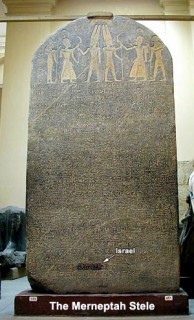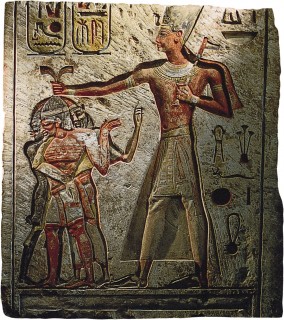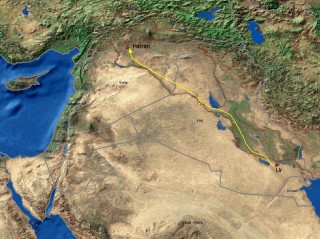 “Take Egypt out and the whole structure of the Israelites’ tale would instantly fall.”
“Take Egypt out and the whole structure of the Israelites’ tale would instantly fall.”
Dr. Ashraf Ezzat
Did you know that Egypt is mentioned in the Holy Bible approximately 700 times (Egypt: 595 times, Egyptian(s): 120 times).
Obviously, Egypt must have played a vital role in the history of the Hebrews otherwise it wouldn’t have been such a recurring theme in the Jewish holy book.
Egypt was, and still is, the magnificent overture to the Israelites’ story. Take Egypt out and the whole structure of the Israelites’ tale would instantly fall.
The land of the Nile has been the theater for the Israelites’ epic stories of alleged enslavement, divine retaliation, wandering in the wilderness and finally a breath-taking and logic-defying exit.
But on the other hand, do you know how many times Israel or the Israelites were mentioned in the ancient Egyptian records? … Well, and according to history and the ancient Egyptian meticulous records – get ready for the surprise– once or … maybe none at all.
Now and before I take you on a little journey back in time, around 3000 years ago, I want you to contemplate on this paradoxical ratio 1:700, and try to answer this simple question; what if there was someone who, you were told, talked of you hundreds and hundreds of times, citing places and stories he said had shared with you, only you don’t know who he is or what the hell he is talking about … what do you call that person? … A liar! A deluded person! … or maybe someone who is trying to steal your thunder.
If that is your answer, then we’re having a common ground for my following argument. If not, then, hop on my time machine and let’s visit the ancient Egyptian empire at its zenith.
Once mentioned but never again

The only time Israel was mentioned in the ancient Egyptian texts, the most meticulous and coherent of the world’s ancient civilizations and which covered the chronicles of nearly 3000 years, was in Merneptah Stele, a black granite slab engraved with a description of the victories of king Merneptah– son of the great Ramses II- in a military campaign against the Meshwesh Libyans and their Sea People allies, but its final two lines, line 26 & 27, refer to a prior military campaign in Canaan in the Near East.
The stele which dates to about 1208 BC was discovered by renowned British archaeologist Flinders Petrie at Thebes in 1896.
The Inscription contains a hymn and a list of the Pharaoh’s military victories. A tribe, whom Merenptah had victoriously smitten”I.si.ri.ar?”Or as Petrie quickly suggested that it read: “Israel!” is on the list of conquests. The mention of Israel is very short; it simply says, “Israel is laid waste, its seed is no more.”
Watch the video of the Merneptah Stele as dispalyed in the Egyptian museum
However, a number of alternative readings for the text “I.si.ri.ar” have been suggested and debated. The most common alternative suggested is that of Jezreel (city) or the Jezreel Valley.
This was the first extra-biblical Egyptian source to mention the tribe of Israel and the last one for that matter.
Yes, maybe the tribe, not the kingdom, of Israel had been mentioned in King Merneptah Stele, but it was ascertained to be completely devastated and existed no more. Interestingly enough, the Israelites were depicted (with distinctive hieroglyphs) in the Egyptian stele as Bedouins/nomads who were always on the move and who never settled in one place/city- contrary to the Israelite story of invasion and settlement they have been raving about during long centuries of silent Egyptian records- the ancient Egyptian writing, Hieroglyphs, has been deciphered in 1822 by Jean Francois Champollion

While the other defeated Egyptian enemies listed besides Israel in Merneptah stele such as Ashkelon, Gezer and Yanoam( cities to be inhabited later by pelset/philistines )were given the determinative for a city-state—”a throw stick plus three mountains designating a foreign country”—the hieroglyphs that refer to Israel instead employ the determinative sign used for foreign peoples: a throw stick plus a man and a woman over three vertical plural lines. This sign is typically used by the Egyptians to signify nomadic tribes without a fixed city-state, thus implying that ysrỉꜣr “Israel” was the demonym for a seminomadic population who were always on the move at the time the stele was created.
Unlike the old school of biblical archeology, which grabbed the spade in one hand and the bible in the other, modern archeologists describe their approach as one which views the Bible as one of the important artifacts into which centuries of Near Eastern cultural accumulations [Egyptian, Phoenician and Sumerian] had been integrated and sometimes copycatted [but] not the unquestioned narrative framework every archaeological find has to fit into.
Despite the scarcity of archeological finds that corroborate the veracity of the Hebrew bible’s narrative, modern archeology doesn’t deny the Israelites existed; rather it states they only existed quite differently.
For example, current Egyptology and Archaeology deny that there was an Exodus. Instead, they say that this is a confused memory of the Expulsion of the Hyksos from Egypt while stressing the fact that Hyksos had nothing to do with the Israelites.
Since relentless excavations of Canaan/Palestine by Israeli and western archeologists since the beginning of the twentieth century only widened the gap between the historical truth as academics know it and the tales of the Hebrew bible, I thought maybe we could look for the missing part somewhere else. And since more consistent and reliable documentation is needed, we should therefore try and look for the truth in Egypt.
Egyptian hegemony over the Levant / Canaan

The bible chronology ironically places the exodus at around 1200BC, in the same period king Merneptah and his father Ramsses II ruled over Egypt, whose documented legacy speaks nothing of, or even close to, this Hebrew tale of “Great Escape” from the Nile valley.
On the contrary, king Merneptah leaves behind no tales of bewitched snakes or parting sea but only his famous stele which bears witness to the devastation of the Hebrew tribe.
The ancient Egyptian civilization depended entirely upon geography and that’s what mainly distinguished it from the Mesopotamian civilization.
The land of Egypt enjoyed many natural barriers; there were deserts to the east and west of the Nile River, and mountains to the south and the Mediterranean Sea to the north. This isolated the ancient Egyptians and allowed them to develop a truly distinctive culture.
While Ancient Egyptian Empire was centered around the Nile River, Egypt’s kings consistently affirmed their control far and beyond the country’s eastern borders and spread their influence over a great chunk of the Levant in order to secure trade routes and relations with eastern powers.
So the territory known today as Palestine/Israel, Jordan, Lebanon and South Syria was practically under Egyptian sovereignty with fortified military garrisons and castles all over the area. And hence the hilarious part of the exodus tale is exposed. For you don’t exit the US by fleeing New York and heading for Massachusetts. Sinai and Canaan was very much Egyptian territory at the time.
The chieftains of Canaan’s tribal communities and leaders of the small cities had to pledge loyalty to the mighty king of Egypt. In return they would be granted his majesty’s protection and support in times of hardships. (Have you ever heard of Egyptian presence in Canaan in the narrative of the Hebrew bible, I don’t think so)
An example to the Egyptian hegemony over the Levant / Canaan, particularly during the new kingdom (1570 – 1070 BC), is the valley of Meggido.
Megiddo is the biblical city of Armageddon that stands above the plain where, at the end of the world, the final/ mythological battle between the armies of the Lord and the kings of the earth will be fought out, as the Book of Revelations tells (Revelations 16:16).
According to the documented/orthodox history, besides being the place of one of the greatest battles in the Egyptian empire, Meggido was merely one of those obscure tribal centers concentrated in land valleys and scattered along the Egyptian international trade roads. Its semi-nomadic people earned their living by shearing wool from sheep.
And to get a clearer picture of how the so called biblical cities depended entirely on Egyptian protection and support and how it was essential for their chieftains/leaders to show their unflinching loyalty to the Egyptian monarchy; Here is one of the famous Amarna letters, discovered in 1887, in which Biridiya, the chieftain of Meggido is practically groveling for the help of king Amenhotep IV (Akhenaten, 1350-1334).
Notice that Biridiya is addressing the king of Egypt as “my lord, my god and son” and not as “Pharaoh”- another Biblical myth the writer of this essay consistently refutes.
Letters from Biridiya of Megiddo
“To the king, my Lord and my God and Sun, thus speaks Biridiya, the loyal servant of the king: At the feet of the king, my Lord and my God and Sun, seven times and seven times I prostrate myself.
May the king know that since the archers have gone back, Labayu [chieftain of Shechem/ biblical town of Jacob and where Joseph is allegedly buried] carries out acts of hostility against me, and that we cannot shear the wool and that we cannot pass through the gate in the presence of Labayu, since he knows that you have not given (me) archers; and now he intends to take Meggido, but the king will protect his city so that Labayu does not seize her. In truth, the city is destroyed by death as a result of pestilence and disease. Grant me one hundred garrison troops to guard the city, lest Labayu take it. Certainly, Labayu has no another intentions. He tries to destroy Meggido.”
So the biblical city of Meggido was so small and feeble that 100 garrison troops were enough to secure and defend it against a takeover by another tribe. And that was during a period of time supposedly referred to in the Israelite history as the Settlement in Canaan (Judges Period)
Geopolitics and landscape of ancient Canaan

Actually the Hebrew bible sketched such a misleading landscape for the land of Canaan; it is depicted as an attraction site for different peoples that even the god of the Israelites, who obviously suffered from geographical illiteracy, eyed it as his promised land.
Canaan’s miscellaneous landscape, framed by sea and desert, by Egypt and Anatolia, part bad lands, part green plains, never lent itself to the notion of nationhood. In the mountains it was hard enough to survive, let alone indulge in the luxury of court politics. And in the plains, the cities of central and southern Canaan were all on the ancient highways, on the roads to somewhere else, between Egypt and the Hittites and Mesopotamia
Moreover, the biblical description is obviously unfamiliar with the geopolitical reality in Palestine. Palestine was under Egyptian rule until the beginning of the first millennia BC. The Egyptians’ administrative centers were located in Gaza, Yaffo and Beit She’an. Egyptian presence has also been discovered in many locations on both sides of the Jordan River.
This striking presence is not mentioned in the biblical account, and it is clear that it was unknown to the author/Hebrew scribe and his editors
Moreover, the archaeological findings blatantly contradict the biblical picture: the Canaanite cities were not ‘great,’ were not fortified and did not have sky-high walls – as in the notorious story of the walls of Jericho. The heroism of the conquerors, the few versus the many and the assistance of the God who fought for his people is but a theological reconstruction lacking any factual basis.
Though Merneptah stele was the only Egyptian reference to mention Israel, but it wasn’t the only reference on military campaigns in Palestine/Canaan. Other Egyptian kings from the new kingdom (1550 – 1069 BC) have left us valuable inscriptions (on stele and temple walls) that documented many of their battles in Canaan as did king Ramses II in his famous battle with the Hittites in Kadesh (1274 BC)- though the documents of the battle, one of the earliest in history, made references to the major Canaanite/Levantine cities at the time, none of the biblical towns as frequently cited in the Hebrew’s holy book, were ever mentioned in the Kadesh chronicles.
The sea peoples’ invasion of Canaan
In Year 8 of the reign of king Ramsses III, the Sea Peoples, most arguably from the Aegean & the Ionian islands, dared to wage an unprecedented offensive war against Egypt by land and sea. King Ramsses III defeated them in two victorious land and sea battle (1178 BC)
This battle has been described as ‘the first naval battle in history’. The details of the combat are meticulously recorded on the walls of the mortuary temple of king Ramesses III at Thebes/Medinet Habu– one of the largest and best-preserved temples in Egypt.
[youtube P9mfoSEvC7o The raids of the Sea Peoples on the Levant]
Although he had defeated the Sea Peoples, king Ramsses III could not ultimately prevent some of them (specifically the Peleset/philistines) from eventually settling in Canaan and Palestine some time after his death
At Medinet Habu Ramses III displayed the names (with their stylized images) of seven of his defeated enemies who constituted the belligerent coalition of the sea peoples along with the then major political players in Canaan, who were either defeated or tempted to join the sea people’s incursion on Egyptian borders:
The names on the inscription were:
(Hittites) The wretched chief of Kheta as living captive.
(Amorites) The wretched chief of Amor.
(Tjekker) Chieftain (lit. the Great One) of the foe of Thekel (TAkwrA).
(Sherden) Sherden (SArAdAnA) of the sea.
(Bedouins) Chieftain of the foe of Sha[su] (SA ///).
(Teresh) Teresh (tjwrASA) of the sea.
(Philistines) Chieftain of the Pe[leset] (pw //////).
The Bible paints the Philistines – one of the identified seven factions of the belligerent coalition against Ramsses III – as the main enemy of the Israelites with a state of almost perpetual war between the two peoples, that was often embroidered with mythical tales of heroism (David vs. goliath)
Since the battle of king Ramsses III took place at a time leading up, according to the Israelite chronology, to the United Monarchy (1030-931 BC) one would anticipate, if Ramsses III’s infantry units were forced into combat with all the major players in Canaan including the Hittites, Amorites and the Philistines, to find Israel/Israelites amongst them.
But again, that was not the case. The well preserved records of Ramsses III’s battle in Canaan insist but to exclude the Israelites out of the historical/geopolitical scene of the region and paradoxically few years prior to the establishment of David & Solomon alleged kingdom.
And while we could easily distinguish the philistines among the engraved inscriptions on the walls of Medinet Habu, the Israelites are nowhere (in the Egyptian documentation) to be found.
Now, the obvious question is where in the archaeological record are the Israelites that King Merneptah fought?
 However, Prof. Ze’ev Herzog of the Archaeology Faculty at the University of Tel Aviv, asserts that there is no evidence in the archaeological record that Israel was ever a powerful force, whether at the time of the Merneptah stele’s creation or at any other time during that general period.
However, Prof. Ze’ev Herzog of the Archaeology Faculty at the University of Tel Aviv, asserts that there is no evidence in the archaeological record that Israel was ever a powerful force, whether at the time of the Merneptah stele’s creation or at any other time during that general period.
The conditions in ancient Palestine were inhospitable for urban settlement nor the development of any kingdom for that matter, and certainly no showcase projects such as the Egyptian shrines/temples or the Mesopotamian palaces could have been established there.
The Egyptian documents make no mention of the Israelites’ presence in Egypt and are also silent about the events of the Exodus. Nevertheless, the documents do mention the custom of nomadic shepherds to enter Egypt during periods of drought and hunger and to camp at the edges of the Nile Delta. However, this was not a solitary phenomenon: such events occurred frequently over thousands of years and were hardly exceptional.
In his article “Deconstructing the Walls of Jericho“, appearing in Ha’aretz (29 October 1999), Ze’ev Herzog calls the mention of Israel on the stele a reference to “population group of nomads” who most probably were always on the move, looking for fertile land to herd their animals. In the article Herzog concludes
“Following 70 years of intensive excavations in the Land of Israel, archaeologists have found out: The patriarchs’ acts are legendary stories, we did not sojourn in Egypt or make an exodus, and we did not conquer the land. Neither is there any mention of the empire of David and Solomon. Those who take an interest have known these facts for years, but Israel is a stubborn people and doesn’t want to hear about it.”
Many historians today agree that at best, the stay in Egypt and the exodus events occurred among a few families and that their private story/vague memory/ folk tale was expanded and ‘nationalized’ to fit the needs of theological ideology- very much similar to how modern-day Zionism has nationalized those remote and inconsistent Jewish tales to serve its political project in Palestine.
Having clarified that chapter of the history of the Egyptian empire in the late Bronze Age during which it controlled all of Canaan and practically most of the Levant I think it is becoming less of a puzzle for us why Egypt hardly mentioned or referred to Israel in its records whereas the Israelites were raving about Egypt all the time.
While Egyptians were occupied with the task of weaving the fabric of a unique culture and building an empire, the Israelites were busy telling fables and fictitious stories that grew bigger all the time as they wandered around.
For more articles by Dr. Ashraf Ezzat visit his website

Ashraf Ezzat is an Egyptian born in Cairo and based in Alexandria. He graduated from the faculty of Medicine at Alexandria University.
Keen not to be entirely consumed by the medical profession, Dr. Ezzat invests a lot of his time in research and writing. History of the ancient Near East and of Ancient Egypt has long been an area of special interest to him.
In his writings, he approaches ancient history not as some tales from the remote times but as a causative factor in our existing life; and to him, it’s as relevant and vibrant as the current moment.
In his research and writings, Dr. Ezzat is always on a quest trying to find out why the ancient wisdom had been obstructed and ancient spirituality diminished whereas the Judeo-Christian teachings and faith took hold and prospered.
Dr. Ezzat has written extensively in Arabic tackling many issues and topics in the field of Egyptology and comparative religion. He is the author of Egypt knew no Pharaohs nor Israelites.
He writes regularly at many well-known online websites such as Dissident Voice and What Really Happened.
Dr. Ezzat is also an independent filmmaker. His debut film was back in 2011 The Annals of Egypt Revolution and in 2012 he made Tale of Osiris a short animation for children.
In 2013 his short The Pyramids: story of creation was screened at many international film festivals in Europe. And he is working now on his first documentary “Egypt knew no Pharaohs nor Israelites”.
ATTENTION READERS
We See The World From All Sides and Want YOU To Be Fully InformedIn fact, intentional disinformation is a disgraceful scourge in media today. So to assuage any possible errant incorrect information posted herein, we strongly encourage you to seek corroboration from other non-VT sources before forming an educated opinion.
About VT - Policies & Disclosures - Comment Policy




